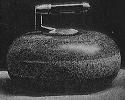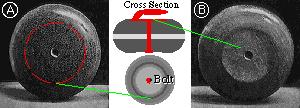
The Very Basics
Curling is played on ice with (approximately) 42-pound granite stones. The size of the playing surface (a 'sheet') is 146 feet long by approximately 14 feet wide. The goal is, after all 16 stones are played (8 by each team), to have a stone of your team's closest to the center of the house, called the 'button'. This is accomplished by sending your stone to rest in scoring position (a 'draw'), by knocking your opponent's stones out of scoring position (a 'takeout'), and by guarding your own stones with others. The team with the closest stone, inside the house, scores a point, or more if they also have the second closest stone and so on. Each round is called an 'end' and consists of two stones delivered by each player on each four-player team. The stones are delivered from the hack on one end of the sheet to the house on the opposite end. This consists of the player pushing off from the hack with the stone and releasing it with a spin, or 'curl', which gives Curling its name.
The Ice (Sheet)

Each end of the sheet has 3 lines drawn from sideline to sideline. They are as follows: The back line (not shown in the above diagram) is located at the edge of the rings closest to the hack; the tee line runs through the centre of the rings and the hog line out in front of the rings.
The hack is where you put your feet to start your delivery.
There are four circles that make up the house. The outer edge of the outer circle has a radius of 6 feet, the next circle has a radius of 4 feet the third circle has a radius of 2 feet and the inner circle (also known as the 'button') has a radius of 6 inches.
The pebble is what helps the stone pick up the lateral motion. The ice is sprinkled before the game with a 'pebbler', which creates a smoothly hilly effect on the ice, much like little pebbles. Without the pebble, the stone would not be able to travel as far. Our best guess, based on what we've been told by people who know, is that the small travelling surface of the stone itself combined with the small contact area of the ice (created by the pebble) creates the same effect you get when you brake on an ice patch. A thin film of water on top of ice creates a hydroplane. Using brooms, the sweepers slightly warm the pebble and thereby increase this effect, causing the stone to glide farther and grip less (which also has the effect of lessening the lateral motion due to curl).
The Curling Stone

The curling stone originated in Scotland from large chunks of rock bowled across the ice, none having any particular size or shape (see curling history). They evolved into what are now matched sets of fairly uniformly made stones. They are all made of pure granite, and they are amazingly hard. The best stones come from a single granite mine on an island off the coast of Scotland. Shipping is quite expensive due to weight (16 stones in a set at 42 pounds a piece, not including packaging), and manufacturing is expensive because of the toughness of the material, which is ground with diamonds.

The stone is concave on both the upper and lower surfaces. On some stones, the degree of concavity is different on both sides to allow for reversing the stone for 'faster' or 'slower' ice. A handle, usually on a circular plastic disc, is bolted onto the stone through a channel running through the middle of the stone to a bolt on the other end, as shown in the red highlighted region in the cross-sectional diagram. The figure on the right shows the top of the stone, more obviously concave, but without a smooth running surface. The handle is affixed onto this circular surface.
In the figure above, part A is the bottom of a curling stone, which is concave, although you can't see it well in this picture. The red circle is the actual running surface of the stone. This allows the stone to go farther, more accurately, and pick up more 'curl'
than would be possible on a flat surface. There is a lighter-colored band in a ribbon around the curling stone. This is the 'striking surface'. In manufacturing, the entire stone is very highly polished but the striking surface is dulled down for the purpose of improving collisions with other stones, both so that there will be a larger contact patch in the collision and so that the stones will not chip.
Curling is always mentioned as a game of strategy by curlers, partly because it is, but also probably because they want to make sure that it's seen as more than throwing rocks and slipping around on the ice. Strategy is definitely the big thing in competitive curling, though. A great deal of effort goes into planning an end so your team's stone ends up closest to the center.